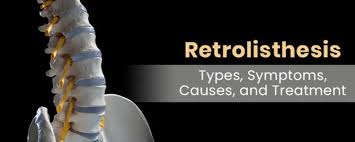
Retrolisthesis occurs when a vertebra slips backward. Many spinal problems affect anatomy, function, and health. Displacement of one vertebra backward beneath or alongside a spinal disc, is a rare joint condition. Although the illness can develop in the thoracic spine, it is unusual. A vertebra’s displacement does not have to be large to disturb the spine’s alignment and biomechanics; even a two-millimeter shift might have negative consequences.
Retrolisthesis
The spine is an essential part of human anatomy; it not only allows us to stand straight, maintain excellent posture, bend, twist, lift, and move, but it also gives the body structure and collaborates with the brain to build the central nervous system. Because the spine is involved in almost every system in the body, any disorder that impairs its health or function can have a wide range of consequences. Misalignment of the spine has a deleterious impact on its biomechanics, function, and general health.
Retrolisthesis is a rare ailment that requires proactive treatment with a combination of chiropractic adjustments, physical therapy, and condition-specific exercises. Treatment effectiveness requires restoring the condition of the damaged disc while also developing core strength for appropriate spinal support.
Causes
It occurs when the distance between the vertebrae decreases. This can happen if vertebral discs shrink. The following variables may trigger this shrinkage and result in retrolisthesis:
- Degenerative spinal issues
- Arthritis and congenital impairments
- Possible causes of spinal injuries include a weak abdomen and surrounding muscles, as well as blood or bone infections.
Types
It is classified into numerous kinds according to the slippage’s direction and severity:
Complete Retrolisthesis
In this case, the afflicted vertebra entirely slips backward over the next vertebra, causing substantial displacement and perhaps damaging nerve roots or the spinal cord. Complete retrolisthesis is usually linked with severe symptoms that necessitate immediate medical intervention.
Partial Retrolisthesis
This form involves a partial backwards dislocation of the vertebra, with less slippage than total retrolisthesis. It can cause discomfort, stiffness, and neurological difficulties, but the severity depends on displacement.
Dynamic Retrolisthesis
Dynamic retrolisthesis, as opposed to static retrolisthesis, which maintains steady displacement, involves movement-induced slippage. Here, the vertebra only moves backwards when specific events happen, like when you do certain things or change your position.
Degenerative Retrolisthesis
Degenerative alterations in the spine, such as disc degeneration, facet joint arthritis, and ligamentous laxity, can cause retrolisthesis. It is frequent in older people and develops slowly. It can also often be associated with other spinal degenerative problems and might worsen with age.
Traumatic Retrolisthesis
Spinal trauma or damage, such as fractures or dislocations, can cause retrolisthesis. The severity of traumatic retrolisthesis varies with the amount of the injury, and rapid medical intervention may be required to stabilize the spine and avoid additional damage.
Non-Surgical Treatment Options
Physical therapy such as targeted exercises can strengthen the muscles supporting the spine, increase flexibility, and relieve discomfort caused by retrolisthesis. Massage, spinal manipulation, and mobilization are all examples of manual therapy techniques that can help relieve muscular tension, improve spinal alignment, and increase mobility. Postural training such as teaching patients proper body mechanics and ergonomics can help reduce stress on the spine and prevent symptoms from worsening.
Discomfort management like medications such as NSAIDs, muscle relaxants, and analgesics may be recommended to reduce discomfort and inflammation caused by retrolisthesis.
Epidural steroid injections can give targeted pain relief by decreasing inflammation and swelling near damaged nerves. Local anesthetic injections directed at specific nerves can help block pain signals and provide temporary relief from symptoms.
Alternative Therapy
Traditional Chinese acupuncture may help retrolisthesis patients relax, reduce pain, and enhance circulation. Spinal manipulation and other chiropractic procedures may alleviate symptoms and improve spinal alignment in certain people. Yoga and Pilates are mind-body techniques that emphasize core muscle strength, posture improvement, and flexibility, all of which can benefit people with retrolisthesis.
Surgical Options
Its surgery is frequently needed when conservative treatment fails and the problem is severe and causes spinal instability or neurological deficits. Different surgical methods can treat retrolisthesis, depending on the patient’s demands. Retrolisthesis patients often have decompression surgery to relieve spinal cord or nerve root pressure. The nerves may be accommodated via laminectomy, which removes part of the lamina. Another decompression treatment, foraminotomy, widens the neural foramen to ease nerve compression. A discectomy can also remove herniated or degenerative intervertebral discs that pressure nerves.
In cases of severe spine movement or instability, dynamic stabilization can treat retrolisthesis. Implants between adjacent vertebrae’s spinous processes prevent motion and stabilize the spine. Spine immobilization, alignment, and fusion can be achieved with pedicle screws and rods. A full assessment and consultation with pain physicians in Dallas are required to determine the best surgical approach for each individual case, with the goal of minimizing symptoms, restoring spinal function, and improving quality of life.
Conclusion
Retrolisthesis care demands a personalized strategy. Other treatments try to ease symptoms, make the spine work better, and raise quality of life. Surgery may be an option for people whose symptoms are serious or getting worse and won’t go away with non-surgical treatments. Pain management in Dallas, and interdisciplinary healthcare professionals must work together to improve treatment outcomes and spinal health.








6d75h1